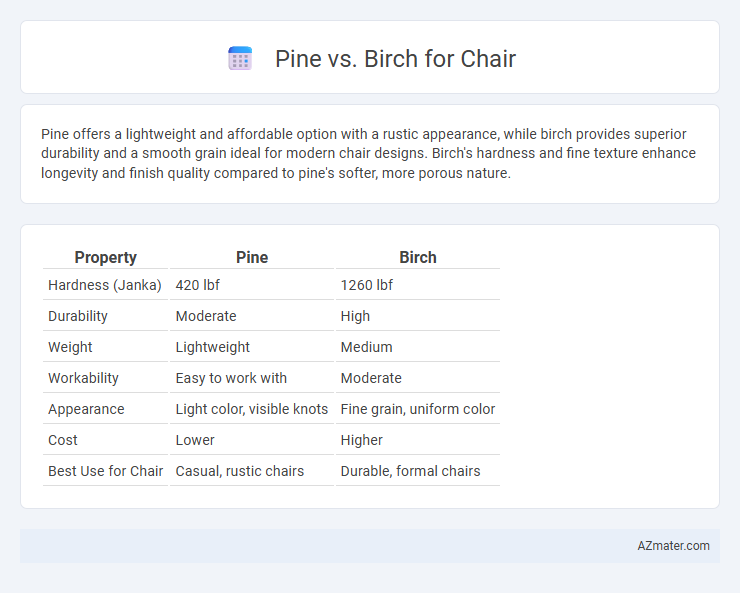Pine offers a lightweight and affordable option with a rustic appearance, while birch provides superior durability and a smooth grain ideal for modern chair designs. Birch's hardness and fine texture enhance longevity and finish quality compared to pine's softer, more porous nature.
Table of Comparison
| Property | Pine | Birch |
|---|---|---|
| Hardness (Janka) | 420 lbf | 1260 lbf |
| Durability | Moderate | High |
| Weight | Lightweight | Medium |
| Workability | Easy to work with | Moderate |
| Appearance | Light color, visible knots | Fine grain, uniform color |
| Cost | Lower | Higher |
| Best Use for Chair | Casual, rustic chairs | Durable, formal chairs |
Overview: Pine vs Birch for Chair Making
Pine and birch are two popular hardwood choices for chair making, each offering distinct qualities in durability and appearance. Pine is a softer wood with a lighter color and prominent grain patterns, making it easier to shape but more prone to dents and scratches. Birch, a harder and denser wood, provides superior strength and a smoother finish, ideal for chairs requiring long-lasting resilience and a polished look.
Wood Characteristics: Pine and Birch Compared
Pine wood is lighter with a soft texture and prominent grain patterns, making it easy to work with but more prone to dents and scratches, whereas birch offers a harder, denser surface that provides greater durability and resistance to wear. Birch's fine, even grain and pale color contribute to a smooth finish ideal for modern chair designs, while pine's natural knots add rustic charm suited to casual or country-style furniture. Both woods are versatile, but birch is preferred for long-lasting furniture due to its strength and better resistance to moisture and impacts.
Strength and Durability: Which Wood Lasts Longer?
Pine, a softwood, is generally less dense than birch, making birch stronger and more durable for chair construction. Birch's tight grain and hardness resist dents and wear, contributing to a longer lifespan compared to the softer, more flexible pine. For furniture subjected to frequent use, birch chairs maintain structural integrity and appearance significantly better over time.
Appearance and Grain Patterns
Pine chairs display a light yellow to pale brown hue with distinctive knots and a straight, uniform grain pattern, adding a rustic and warm charm to furniture. Birch wood features a fine, even texture with a creamy white to light reddish-brown color and subtle, flowing grain patterns that offer a sleek and modern aesthetic. The contrast between pine's prominent knots and birch's smooth grain makes pine ideal for a cozy, country style while birch suits contemporary and clean designs.
Workability: Ease of Crafting Chairs
Pine offers excellent workability for chair crafting due to its soft texture, allowing easier cutting, shaping, and smoothing with hand tools or machines. Birch is harder and denser, requiring more effort to carve but provides superior strength and durability, making it ideal for chairs needing long-term resilience. Woodworkers often choose pine for quick projects and birch for finely detailed, robust chair designs.
Cost Differences: Pine vs Birch
Pine chairs are generally more affordable than birch due to the faster growth rate and wider availability of pine wood, making it a cost-effective option for budget-conscious buyers. Birch, being a hardwood with a denser grain and higher durability, commands a higher price point, reflecting its superior strength and longevity in furniture construction. The price difference between pine and birch chairs can significantly impact overall project budgets, especially in bulk purchases for commercial or residential use.
Environmental Impact and Sustainability
Pine chairs generally have a lower environmental impact due to faster tree growth rates and higher availability, which enables more sustainable harvesting practices compared to birch. Birch requires longer growth periods and often grows in regions with slower forest regeneration, making it less sustainable for mass furniture production. Choosing pine supports reduced deforestation rates and promotes efficient carbon sequestration, enhancing its eco-friendly profile in chair manufacturing.
Maintenance and Care Requirements
Pine chairs require regular sealing or varnishing to protect against moisture and dents, making maintenance necessary but manageable with routine care. Birch chairs are more resistant to wear and often need less frequent refinishing; however, they still benefit from periodic polishing to maintain their smooth finish. Both woods should be cleaned with mild soap and water to prevent damage, but pine's softer texture makes it slightly more susceptible to scratches and dents over time.
Best Applications: When to Choose Pine or Birch
Pine wood is ideal for rustic or casual chair designs due to its affordability, lighter weight, and softer texture, making it suitable for indoor furniture that doesn't require heavy durability. Birch wood, known for its strength, hardness, and fine grain, is better suited for high-use chairs or those requiring a smooth finish and resilience against wear. Choosing pine is best for budget-friendly, decorative chairs, while birch is preferred for sturdy, long-lasting seating with a polished appearance.
Final Verdict: Pine or Birch for Chairs?
Birch offers superior strength and durability compared to pine, making it a better choice for chairs that require long-lasting support and resistance to wear. Pine is softer and more affordable but may dent or scratch easily, suitable for lightweight or decorative seating. For high-traffic or heavy-use chairs, birch is the recommended wood due to its robust grain and hardness.

Infographic: Pine vs Birch for Chair
 azmater.com
azmater.com